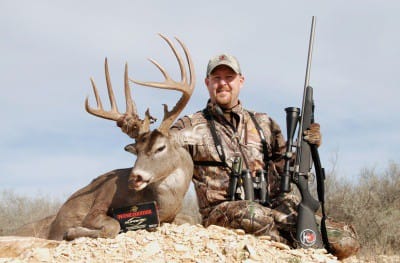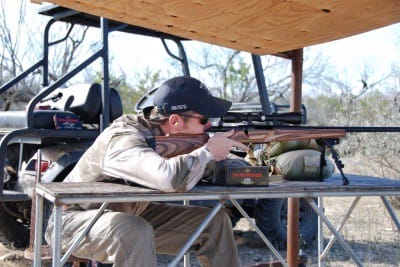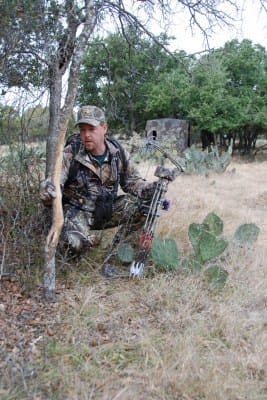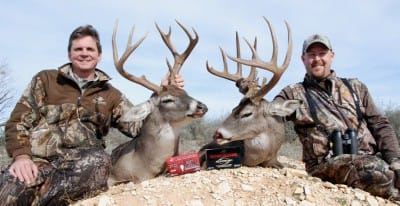Submitted By:
Tim Herald-USA Guest Author
 Texas has long been known as a top destination for whitetail hunters, and it was in the Lonestar State that deer management was really born. After 50 years of managing their deer herds, Texans provide about the most fun hunts with incredible success rates that can be found anywhere.
Texas has long been known as a top destination for whitetail hunters, and it was in the Lonestar State that deer management was really born. After 50 years of managing their deer herds, Texans provide about the most fun hunts with incredible success rates that can be found anywhere.
Seasons are liberal in Texas, and rifles may be used from early November into early January, and many good ranches are registered members of the Texas state management program that allows even longer seasons. It is the season structure, and the knowledge that you can see more bucks on a four-day hunt in Texas than you may see in two seasons at home, that prompt me to end my deer season each fall somewhere in Texas.
A few other benefits of hunting late in Texas are the fact that you will usually experience mild weather, license and tags are over the counter, there is a plethora of quality operations to hunt with, and you can learn a lot about deer management and behavior in a short time. Did I mention it is just plain fun?
Texas deer hunts are usually relaxed affairs as well. You stay in a nice ranch house, eat well, and go out for a few hours in the morning and the last two or three hours in the afternoon. If you are hunting on a quality ranch, you will see multiple bucks each sit, and you can be choosy about the deer you shoot, meanwhile you get to watch a lot of deer doing what deer do. I know for me personally, it is a nice change to go to the stand and be able to watch bucks and does interact after a long season back home where there are days I just hope and pray to lay eyes on a single buck.

Food sources for Texas deer vary by ranch, but if you have oaks, wheat fields, or food plots, whitetails will be concentrated nearby. Supplemental feeding is a given in Texas, and corn and protein pellets are used extensively. Stationary feeders and scattering corn in open areas or on ranch roads are strong attractants, and will bring deer out of the dense brush so they may be more easily seen.
While I go during rifle season, I have opted to hunt with bow and muzzleloader on a couple of trips. This season, I did take my old reliable setup, a TC Icon in .300 Win, topped with a Nikon Monarch 4x16x50, shooting 180 grain Winchester E-Tips. I stay zeroed at 200, and that seems to be perfect for most Texas hunting situations.
I hunted the week between Christmas and New Year’s on the low-fenced Canyon Ranch with SOE Hunts out of Uvalde. I was part of a group of nine hunters, and we had a typically successful hunt with pleasant temperatures while a major snow storm and single digit temps plagued my home in Kentucky.
The first morning of my hunt was cool and foggy. I was in a blind set back in the brush, and there was a feeder about 100 yards away. I could also see down a dry creek bed and across to a hillside that allowed for quite a bit of glassing.
As dawn penetrated the dense fog, I could barely pick out forms moving in and out of the brush through my EDG binocular. With each passing minute, I could distinguish more detail, and after half an hour, I had verified sightings of five different bucks.

The best was an obviously mature 10-pointer with dark antlers that carried long main beams, good mass and high times. The only drawback I had from punching a tag on him was that his G-4 on one side looked either broken or really short. I judged the buck to score in the low 150s, but that early in the hunt, I just hated to shoot a deer with a broken tine. I knew I might kick myself at the end of the hunt, but I opted to pass on the shot.
I saw lots of deer and lots of bucks on the trip, and I genuinely enjoyed every minute on stand. One evening I went out to a blind on a huge oat field that stretched more than 1,200 yards long and was about 200 yards wide. I had been told about a long tined 10 pointer that wasn’t very wide, but would score in the low 150s that had been spotted on the field three times over the past month. The staff of SOE Hunts had named him the “Perkins Buck” after a past hunter that had seen him but didn’t get a shot, and they told me if I saw him, he was very high on the ranch’s hit list.
An hour and half before dark, deer began to filter out of the south Texas brush and hit the oat field. Most were about 900 yards away, and the only way I could tell their gender was by watching the small bucks chase the does. Thirty minutes later, there were over a dozen deer in the field, but I wondered if any would ever show up on my end of the oats.
I scanned the brush across from my blind seemingly 100 times, and at about 4:55 p.m., I caught movement. Soon I determined that it was the legs of a deer about 10 yards off the field edge. I watched as the deer picked its way into the open and immediately knew it was a dandy buck. When he picked his head up, I could see that it was the deer the guides had described, the Perkins Buck.
I grabbed my rifle, cranked up my scope and got into shooting position as quickly and quietly as possible. The big buck was feeding contentedly, so I got settled and took my time lining up the shot.
He was about 160 yards out and calm, so I waited on him to get perfectly broadside. I lined up my crosshairs, took a deep breath and squeezed the trigger gently. Through the recoil, I could see that my gun and load had done their job, as the buck crumbled on the spot.

The Perkins Buck was a typical south Texas trophy. Chocolate antlers, good mass and long tines made this 7 1/2-year-old one of the best looking bucks I have ever taken. What a fantastic way to end a season.



